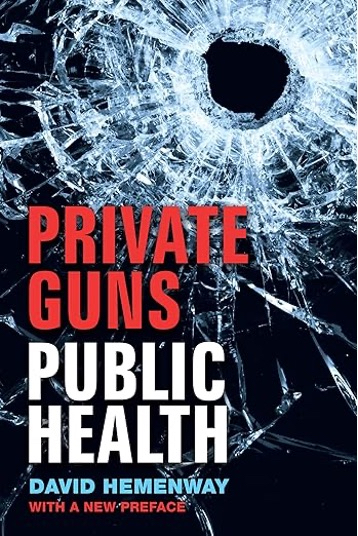A Public Health Approach to Reducing Firearm Violence
An Intriguing WALS Talk Points to a Way Forward
BY ANNELIESE NORRIS, NCI
The United States has, by far, the highest firearm-related violence rates among high-income countries. For example, American children aged 5-14 are 27 times more likely to be victims of firearm violence compared to children in other high-income countries. In 2021, 134 people died in the United States per day from firearm violence—more so from firearm suicides than firearm homicides.

CREDIT: HARVARD UNIVERSITY
David Hemenway explained how harm reduction from gun violence can be addressed by applying a public health approach.
“This is a big public health problem,” said David Hemenway, professor of health policy at Harvard University (Boston), during a Wednesday Afternoon Lecture Series (WALS) talk in January. Fortunately, this is a problem that can be addressed using sound public health approaches.
Hemenway highlighted the successful harm reduction public health campaign for motor vehicle safety as an example of what can be achieved. Fatalities per mile driven have fallen by 90% due to manufacturing safer cars and other efforts to create safer driving environments. Drivers are little different today than in the 1950s, he noted, but the driving environment has made driving safer.
Rumble strips on the sides of highway lanes, reduction of trees lining roads, and the structural, functional, and technological safety modifications automakers have made to create safer vehicles over the years were all examples he offered. “It is hard to change people’s behavior; it is much easier and more cost-effective to make their environments safer,” he explained.
Everyone is part of the gun violence solution
Because the United States has more households with firearms than any other country, a public health approach that gets everyone involved in working toward harm reduction is key.
Applying that same approach to firearms as we did years ago to driving begins with placing less blame and sharing responsibility. A harm-reduction approach involving everyone as part of the solution would include gun manufacturers, gun dealers, gun owners, and gun safety trainers. It also includes those you would not necessarily think of, such as barbers and hairdressers, universities, and even banks—all different sectors of society can help solve the problem.
Safe environments save lives
Hemenway made it clear he is not trying to ban firearms, but he does want to make them safer. For example, modifications can be adopted to reduce firearm accidents by manufacturing personalized firearms—much like a cell phone that can recognize an owner’s fingerprint. Other priorities include training firearm owners on measures to reduce the high suicide rates among them and their families.
One success story Hemenway credits to a Harvard colleague of his, Cathy Barber, who is the founding director of Means Matter, who along with Clark Aposhian, chair of the Utah Shooting Sports Council, helped develop a public service announcement, available on YouTube as "Cathy Barber: “The ‘Perfect’ PSA." Working together, public health and firearm experts created a suicide prevention module, “11 Commandments of Gun Safety,” which is similar to the campaign “Friends Don’t Let Friends Drive Drunk.” The module offers advice such as when an emotional crisis is cause for concern, firearm owners might consider temporary off-site storage of their firearms. “Finding allies among gun owners, it turns out, is not that hard,” said Hemenway.

CREDIT: DAVID HEMENWAY
Hemenway has authored several books on the public health approach to harm reduction.
His small role in helping develop the National Violent Death Reporting System for firearm and other violent deaths is one of the more impactful works of his career, Hemenway said. Here, he helped create the pilot for a system that collects data surrounding the circumstances of all violent deaths. Researchers can request access to the database, and the public can create infographics using the website’s interactive functions.
Moving forward, Hemenway is excited about a project he is embarking on to explore lead poisoning among children of firearm owners. Bullets have lead in them, and after a shot is fired, the lead residue can remain on clothing, and children may eventually eat or inhale the particles. This is an underexplored area of research, and Hemenway is excited to learn more.
An underfunded epidemic of violence
A roadblock for the public health approach to firearm violence harm reduction has been the historic lack of federal funding for research. Hemenway, whose research is funded primarily by foundations, highlighted that firearm research has been grossly underfunded in the United States.
There has been movement on this front, however. A White House initiative established the first Office of Gun Violence Prevention in 2023. NIH established the Firearms Research area of categorical spending in 2020 as part of the Research, Condition, and Disease Categorization system. Each year, OBSSR coordinates the annual $12.5 million appropriations from Congress to conduct research on firearm injury and mortality prevention. Prior to 2020 appropriations, NIH had a small portfolio of firearm injury prevention grants, primarily stemming from investigator-initiated grant applications or under notices of funding opportunities from specific institutes and centers. That research included suicide prevention at NIMH and childhood injury prevention at NICHD, but not all of those projects focused primarily on firearms.
Learn more about the interesting history of the automobile public health and safety campaigns that help keep us all safer today, as well as Hemenway’s other suggestions for improving firearm safety, by watching the WALS Lecture VideoCast recording at https://videocast.nih.gov/watch=51124.
Anneliese Norris, a scientist at NCI, is working on HIV dynamics and replication. In her spare time, she enjoys reading and building with LEGO®.
This page was last updated on Monday, December 2, 2024
